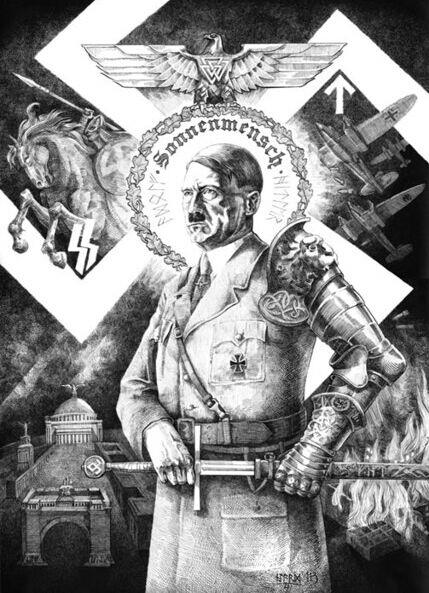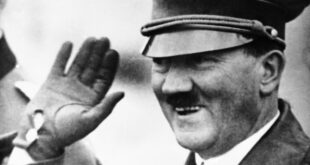Timothy W. Ryback
The Atlantic Monthly
May 2003
You can tell a lot about a person from what he reads. The surviving—and largely ignored—remnants of Adolf Hitler’s personal library reveal a deep but erratic interest in religion and theology
Did you know that today is Hitler’s birthday?” the attendant said as he handed me Adolf Hitler’s personal copy of Mein Kampf, a tattered red-leather volume (a special second edition issued in 1926) with the title and author’s name embossed in gold on the spine. The young man, clean-cut and dressed in a sweatshirt bearing the skull and crossbones of the Curry College Rugby Football Club, explained that he knew this fact only because his sister shared a birthday with the Nazi leader. “You remember something like that,” he said.
On this particular Friday (April 20, 2001, Adolf Hitler’s 112th birthday) the rare-book reading room of the Library of Congress—a high-ceilinged space elegantly appointed with brass lamps, heavy wooden tables, and thick carpet—hummed with subdued activity. At one table a heavy-set woman in a bright paisley blouse wore white gauze gloves to leaf through a fragile tome titled Histoire Aéronautique, a collection of quaint eighteenth-century lithographs depicting aeronauts in powdered wigs transported aloft by fanciful pneumatic contraptions. A smartly dressed black woman with cropped hair and large hoop earrings studied a book on slavery in Barbados. Across from her a stocky man with a laptop clattered away as he typed extracts from a book cradled in a velvet-lined wooden stand. At another table a young man in a suit stared into an oversized volume of black-and-white photographs of graphic sex—leather, chains, sprawled limbs—with SEX embossed on the silver-metal cover.
The rare-book collection is home to more than 800,000 volumes. It contains the personal libraries of Thomas Jefferson, Theodore Roosevelt, and Woodrow Wilson, and first editions of contemporary “authors” such as Andy Warhol and Madonna. It is also home to the remnants of the private library of Adolf Hitler, a man better known for burning books than for collecting them.
The books that constitute the Hitler Library were discovered in a salt mine near Berchtesgaden—haphazardly stashed in schnapps crates with the Reich Chancellery address on them—by soldiers of the 101st Airborne Division in the spring of 1945. After a lengthy initial evaluation at the U.S. military “collecting point” in Munich the books, numbering 3,000, were shipped to the United States and transferred in January of 1952 to the Library of Congress, where an intern was assigned to uncrate the collection. “The intern did what we call ‘duping out,'” says David Moore, a German-acquisition assistant at the Library of Congress. “If a book was not one hundred percent sure, if there was no bookplate, no inscription to the Führer, he didn’t keep it.” According to Moore, duplicate copies were sent to the exchange-and-gift division and then either went to other libraries or found their way onto the open market; the non-duplicate books that could not be fully authenticated were absorbed into the Library of Congress’s general collection.
The 1,200 volumes that survived the “duping out” joined the rare-book collection on the third floor of the Jefferson Building, where they were unceremoniously identified by a large cardboard sign—dangling on a string from a ceiling pipe—that read, “Hitler Library. This bay only. Please replace books to proper location.”
The sign has since been removed, the books relocated several times, and the collection euphemistically renamed the Third Reich Collection. The books can be ordered, five at a time, from the main desk in the rare-book reading room. When I first visited the collection, in April of 2001, fewer than half of the 1,200 books had Library of Congress numbers, and only 200 of those were listed in the online catalogue; the remaining thousand titles were listed alphabetically by author on yellowing cards in an old-fashioned wooden card catalogue, many still identified by the provisional numbers assigned them in the early 1950s. Jerry Wager, the head of the rare-book reading room, told me at the time, “Processing this collection has not been a high priority for us”; he also said that the books had been relocated yet again in recent months. “We routinely move collections to make better use of existing space and to accommodate new acquisitions,” he said. A genteel man in his mid-fifties with a flawlessly manicured white beard, Wager is a master of discretion. When I asked about the Hitler collection’s new location, he replied, “For security reasons we don’t reveal where collections are located in the vault.” He is equally circumspect about scholars who have previously studied the collection, simply noting that the books are requested only a few times each year, and generally by people looking for specific volumes rather than for an opportunity to study the collection as a whole.
Why, with hundreds of Hitler biographies, had not more scholars visited the Third Reich Collection? It is referenced by none of the leading Hitler biographers—not Alan Bullock, not John Toland, not Joachim Fest. Ian Kershaw, whose recent two-volume Hitler biography has won international acclaim, told me in the summer of 2001 that he visited the collection once, in the early 1990s, but “decided against any consultation of the volumes in it, and in the event did not refer directly, so far as I recall, to the collection in my biography.” In retrospect, Kershaw concedes, he should probably have at least mentioned the collection in a footnote.
cholarly neglect of the Hitler Library derives in good part from an early misperception that its historical or biographical importance was limited. “Spotchecks revealed little in the way of marginal notes, autographs, or other similar features of interest,” an internal Library of Congress review determined in January of 1952. “Indeed, it seems that most of the books have never been perused by their owner.” Gerhard Weinberg, a leading authority on the Nazi era and one of the first scholars to explore the collection, confirms this initial assessment. “I was a newly minted Ph.D., and this was my first job beyond graduate school,” Weinberg told me not long ago. “I was compiling information for the Guide to Captured German War Documents. The books had only recently been uncrated, and I was intrigued by what I would find there.” To Weinberg’s disappointment, the Hitler Library appeared to consist mostly of presentation copies from authors or publishers. “There were few clues that many of these books had been part of his personal library, and even less evidence that he had read any of them,” Weinberg says.
In 2000 Philipp Gassert and Daniel Mattern reached a similar conclusion. Beginning in 1995 Gassert, an assistant professor of history at the University of Heidelberg, and Mattern, the senior editor at the German Historical Institute, in Washington, D.C., systematically reviewed every volume in the collection. In the spring of 2001 Greenwood Press published the results of their research, The Hitler Library, a 550-page bibliography that lists each book alphabetically, with its author, page count, and call number. Also included are transcriptions of all handwritten dedications, some brief descriptions of marginalia, and an indication of which books contain the Führer’s bookplate—an eagle, a swastika, and oak branches between the words EX LIBRIS and ADOLF HITLER.
The Hitler Library provides the first comprehensive road map through the collection, but at times it leads readers astray.
Most significant is overlooked marginalia. In one reference Mattern and Gassert note correctly that the Hitler Library contains two identical copies of Paul de Lagarde’s German Essays, but they don’t mention marginalia, despite the fact that in one volume fifty-eight pages have penciled intrusions—the first on page 16, the last on page 370. Given that Lagarde belongs to a circle of nineteenth-century German nationalist writers who are believed to have had a formative influence on Hitler’s anti-Semitism, the marked passages are certainly worth noting. In an essay called “The Current Tasks of German Politics,” Lagarde anticipates the emergence of a “singular man with the abilities and energy” to unite the German peoples, and calls for the “relocation of the Polish and Austrian Jews to Palestine.” This latter phrase has been underlined and flagged with two bold strikes in the margin.
Sometimes writing along the side of a page is recognizably in Hitler’s jagged cursive hand. For the most part, though, the marginalia are restricted to simple markings whose common “authorship” is suggested by an intense vertical line in the margin and double or triple underlining in the text, always in pencil; I found such markings repeatedly both in the Library of Congress collection and in a cache of eighty Hitler books at Brown University. Hitler’s handwritten speeches, preserved in the Federal German Archives, show an identical pattern of markings. In one anti-Semitic rant Hitler drew three lines under the words Klassenkampf (“class struggle”), Weltherrschaft (“world domination”), and Der Jude als Diktator (“the Jew as dictator”); one can almost hear his fevered tones.
Hitler’s habit of highlighting key concepts and passages is consonant with his theory on the “art of reading.” In Chapter Two of Mein Kampf he observed,
A man who possesses the art of correct reading will, in studying any book, magazine, or pamphlet, instinctively and immediately perceive everything which in his opinion is worth permanently remembering, either because it is suited to his purpose or generally worth knowing … Then, if life suddenly sets some question before us for examination or answer, the memory, if this method of reading is observed … will derive all the individual items regarding these questions, assembled in the course of decades, [and] submit them to the mind for examination and reconsideration, until the question is clarified or answered.
In these marginalia one sees a man (who famously seemed never to listen to anyone, for whom “conversation” was little more than a torrent of monologues) reading passages, reflecting on them, and responding with penciled dashes, dots, question marks, exclamation points, and underscorings—intellectual footprints across the page. Here is one of history’s most complex figures reduced merely to a reader with a book and a pencil.
“Books, books, always books!” August Kubizek once wrote. “I just can’t imagine Adolf without books. He had them piled up around him at home. He always had a book with him wherever he went.” Kubizek, Hitler’s only real friend in his teenage years, recalled after the war that Hitler had been registered with three libraries in Linz, where he attended school, and had passed endless days in the baroque splendor of the Hofbibliothek, the former court library of the Hapsburgs, during his time in Vienna. “Bücher waren seine Welt,” Kubizek wrote. “Books were his world.”
 Daily Stormer The Most Censored Publication in History
Daily Stormer The Most Censored Publication in History



